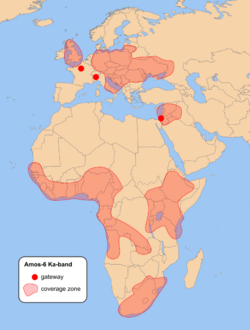Engineering:Amos-6
| Operator | |
|---|---|
| Mission duration | Planned: 15 years,[1] Actual: None |
| Spacecraft properties | |
| Bus | AMOS 4000[2] |
| Manufacturer | Israel Aerospace Industries |
| Launch mass | 5,500 kilograms (12,100 lb)[3] |
| Power | 10 kW[2] |
| Start of mission | |
| Launch date | Destroyed before launch |
| Rocket | Falcon 9 Full Thrust |
| Launch site | Cape Canaveral Air Force Station Space Launch Complex 40 |
| Contractor | SpaceX |
| End of mission | |
| Disposal | Fire in failed launch rehearsal test |
| Destroyed | 13:07, 1 September 2016 (UTC)[4] |
| Orbital parameters | |
| Reference system | Geocentric |
| Regime | Geostationary |
| Longitude | 4°West |
| Perigee altitude | 35,785 kilometres (22,236 mi) |
| Apogee altitude | 35,800 kilometres (22,200 mi) |
| Transponders | |
| Band | 36, 43 Ku band
36, 43 Ka band Two S-band transponders |
| Coverage area |  |
Amos-6 was a 5.5-tonne Israeli Earth communications satellite, one of the Spacecom AMOS series, that was built by Israel Aerospace Industries (IAI), a defense and aerospace company.[5]
Amos-6 was intended to be launched on Flight 29 of a SpaceX Falcon 9 to geosynchronous transfer orbit on 3 September 2016. On 1 September 2016, during the run-up to a static fire test, there was an anomaly on the launch pad, resulting in an explosion and the loss of the vehicle and Amos-6. There were no injuries.[4]
Terminology
Amos stands for "Affordable Modular Optimized Satellite"[5] and is also an allusion to the prophet Amos. This spacecraft is the second implementation of the AMOS-4000 platform, the first was the Amos-4. It is one of a series of satellites built by Israel Aerospace Industries.
History
In January 2013, Spacecom announced that they had signed a contract with SpaceX for the 2015 launch of the Amos-6 satellite on a Falcon 9 launch vehicle.[1] Amos-6 was intended to replace the Amos-2 satellite, planned to be retired in 2016.[6] During 2015 Spacecom announced the launch date had slipped to mid-2016.[1] A final launch date was set for 3 September 2016.
Under the deal with Spacecom, state-owned IAI was contracted to build Amos-6 and its ground control systems, as well as provide operating services.[5] Spacecom estimated that the cost of launching, insuring and one year's operation of Amos 6 would be $85 million.[7]
The Amos-6 included payload components from various sub-contractors including Canada 's MacDonald, Dettwiler and Associates, which built the communications payload, and Thales Alenia Space ETCA for the electric propulsion. The satellite "[incorporated] new technologies that represent a significant leap forward in the capabilities of IAI and the state of Israel in space," according to IAI's president and chief executive, Joseph Weiss.[5]
Lease to external customers
In October 2015, social media company Facebook and satellite fleet operator Eutelsat agreed to pay Spacecom $95 million over a period of about five years for the lease of the Ka-band spot-beam broadband capacity—36 regional spotbeams with a throughput of about 18 Gbit/s—on Amos-6 to provide service for Facebook's Internet.org and a new Eutelsat subsidiary focusing on African businesses.[1] Costs would be divided in approximately equal shares between Eutelsat and Facebook.[8] The parties agreed to the right to terminate the contract if Amos-6 and the ground gateways in France, Italy and Israel were not ready for service by 1 January 2017. The lease was for the use of the satellite until September 2021, with an option for a two-year extension at a reduced rate.[1][8]
After a technical analysis, including an assessment of customer power requirements, Facebook and Eutelsat concluded that only 18 out of the 36 Ka-band spot beams could be used simultaneously without sacrificing user experience.[8]
Destruction
On 1 September 2016, the Falcon 9 launch vehicle suffered an anomaly during fuel loading for a routine static fire test that destroyed the vehicle and its AMOS-6 payload.[4] The explosion started near the upper stage LOX (Liquid oxygen) tank. Because the satellite was destroyed prior to the launch, the cost of the satellite is not covered by Spacecom's insurance policy, but rather by the manufacturer, IAI. IAI has its own insurance and will file a claim in order to compensate Spacecom. Spacecom's contract with SpaceX specifies Spacecom can choose to receive $50 million, or a future flight at no cost.[9][10] Spacecom chose the future flight to launch Amos 17.[11]
News reports in early November indicated that SpaceX had determined root cause for the anomaly, that it was straightforwardly fixable, and that SpaceX would return to flight in December 2016.[12] On 2 January 2017, SpaceX released an official statement indicating that the cause of the failure was a buckled liner in several of the COPV tanks, causing perforations that allowed liquid and/or solid oxygen to accumulate underneath the lining, which was ignited by friction.[13]
See also
- List of Falcon 9 launches
References
- ↑ 1.0 1.1 1.2 1.3 1.4 Peter B. de Selding (6 October 2015). "Facebook, Eutelsat To Pay Spacecom $95M for Ka-band Lease". Spacenews. http://spacenews.com/facebook-eutelsat-to-pay-spacecom-95m-for-ka-band-lease/. Retrieved 10 October 2015.
- ↑ 2.0 2.1 "Israel Aerospace Industries (IAI) has successfully launched Spacecom's AMOS-4". IAI. 31 August 2013. http://www.iai.co.il/2013/36757-45460-en/MediaRoom.aspx.
- ↑ Barbara Opall-Rome (12 October 2015). "IAI Develops Small, Electric-Powered COMSAT". DefenseNews. http://www.defensenews.com/story/defense/2015/10/12/iai-develops-small-electric-powered-comsat/73808432/. Retrieved 12 October 2015.
- ↑ 4.0 4.1 4.2 Malik, Tariq (1 September 2016). "Launchpad Explosion Destroys SpaceX Falcon 9 Rocket, Satellite in Florida". Space.com. Archived from the original on 2 September 2016. https://web.archive.org/web/20160902140256/http://www.space.com/33929-spacex-falcon-9-rocket-explodes-on-launch-pad.html.
- ↑ 5.0 5.1 5.2 5.3 "IAI to launch new 5-ton Amos satellite". spacedaily.com. Space Media Network. 6 July 2012. http://www.spacedaily.com/reports/IAI_to_launch_new_5-ton_Amos_satellite_999.html. Retrieved 4 September 2016.
- ↑ Money, Stewart (30 January 2013). "SpaceX Wins New Commercial Launch Order". Innerspace.net. Archived from the original on 1 February 2014. https://web.archive.org/web/20140201235306/http://innerspace.net/2013/01/30/spacex-wins-new-commercial-launch-order/. Retrieved 1 February 2013.
- ↑ Levy, Aviv (24 June 2012). "Spacecom to build $200m Amos 6 satellite". Globes [online], Israel business news. Globes Publisher Itonut (1983) Ltd.. Archived from the original on 1 September 2016. https://web.archive.org/web/20160901152215/http://www.globes.co.il/en/article-1000759794. Retrieved 4 September 2016.
- ↑ 8.0 8.1 8.2 de Selding, Peter B. (9 October 2015). "Facebook-Eutelsat Internet Deal Leaves Industry Awaiting Encore". SpaceNews. http://spacenews.com/facebook-eutelsat-internet-deal-leaves-industry-awaiting-encore/. Retrieved 4 September 2016.
- ↑ Cohen, Nitzan (September 4, 2016). "Spacecom to claim Amos 6 compensation from IAI". Globes. http://www.globes.co.il/en/article-spacecom-to-claim-compensation-for-amos-6-from-iai-1001149933.
- ↑ ANALYSIS | How SpaceX’s spectacular pre-flight failure fueled a jump in hasty conclusions, SpaceNews, Jeff Foust, 6 September 2016.
- ↑ "Spacecom returns to SpaceX for one, possibly two launches". October 18, 2017. https://spacenews.com/spacecom-returns-to-spacex-for-one-possibly-two-launches/.
- ↑ "Inmarsat, juggling two launches, says SpaceX to return to flight in December - SpaceNews.com". 3 November 2016. http://spacenews.com/inmarsat-juggling-two-launches-says-spacex-to-return-to-flight-in-december/.
- ↑ "January 2 Anomaly Updates". 2 January 2017. http://www.spacex.com/news/2016/09/01/anomaly-updates.
External links


